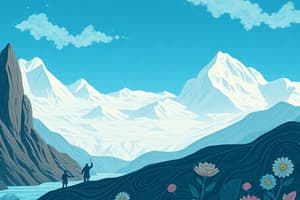Podcast
Questions and Answers
What is the most common process by which glaciers move?
What is the most common process by which glaciers move?
Internal plastic deformation or internal flow.
What is basal sliding?
What is basal sliding?
The movement of an entire glacier as a single unit due to melting at its base.
What causes the formation of crevasses on the surface of glaciers?
What causes the formation of crevasses on the surface of glaciers?
The splitting of upper layers of the glacier as the glacier below moves.
What are crevasses?
What are crevasses?
What factors can increase glacial flow rates?
What factors can increase glacial flow rates?
How fast can the slowest glaciers move?
How fast can the slowest glaciers move?
How fast can the fastest glaciers move?
How fast can the fastest glaciers move?
Why are crevasses dangerous for hikers and mountain climbers?
Why are crevasses dangerous for hikers and mountain climbers?
What are glaciers?
What are glaciers?
How are glaciers created?
How are glaciers created?
What impact does glacier movement have on the Earth's surface?
What impact does glacier movement have on the Earth's surface?
Why do glaciers move?
Why do glaciers move?
What is the rate of movement for most glaciers?
What is the rate of movement for most glaciers?
What conditions are necessary for a glacier to form?
What conditions are necessary for a glacier to form?
Flashcards are hidden until you start studying
Study Notes
Glacier Movement
- Basal sliding is the most common process by which glaciers move.
- Basal sliding is the movement of a glacier over its bed due to meltwater reducing friction.
- Crevasses are large cracks or fissures that form on the surface of glaciers.
- Crevasses form because of the different speeds of glacial ice at the surface and at its base.
- Glaciers move under the influence of gravity and due to their own weight.
- Glacier flow rate can be increased by factors such as slope, temperature, and the amount of meltwater.
- The slowest glaciers can move at rates of less than a meter per year.
- The fastest glaciers can move at rates of up to several kilometers per year.
- Crevasses are dangerous to hikers and climbers because they are hidden by snow and can be fatal if fallen into.
Glaciers Formation
- Glaciers are large masses of ice that form over time, often in mountainous regions.
- Glaciers are created when snow accumulates over a long period and is compressed into ice.
- Glaciers can be formed when enough snowfall exceeds melting and evaporation.
- Glaciers have a significant impact on the Earth's surface, shaping landscapes and creating landforms.
Glacier Impact
- Glacier movement carves out valleys and shapes mountains.
- Glaciers can erode the bedrock and carry sediment, leaving behind deposits of glacial till.
- Glaciers are sensitive to changes in climate and are retreating rapidly in many parts of the world.
- Glacier retreat has consequences for water resources, coastal communities, and ecosystems.
Studying That Suits You
Use AI to generate personalized quizzes and flashcards to suit your learning preferences.




